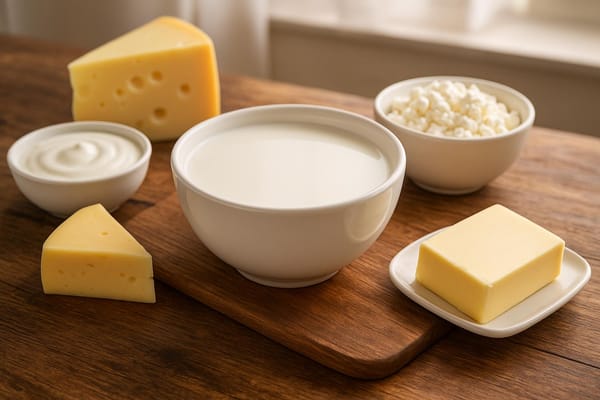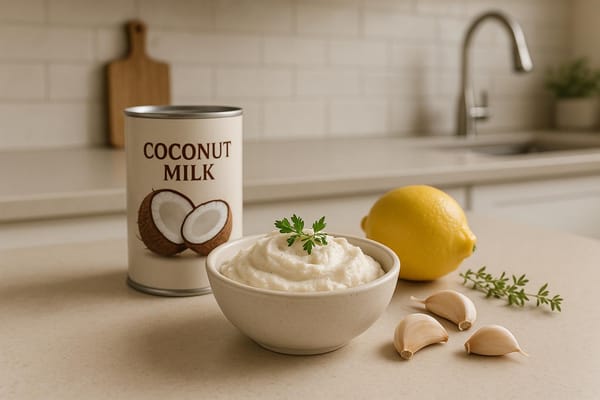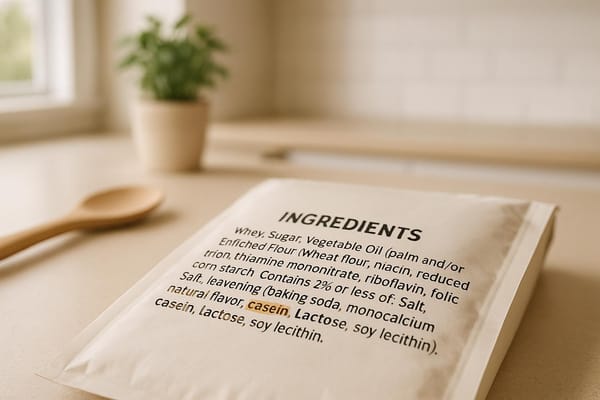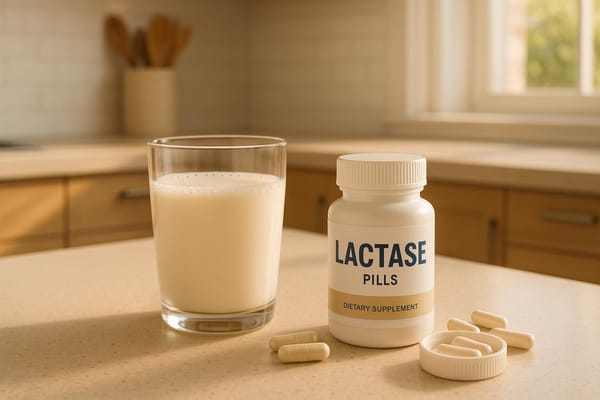How to Spot Hidden Lactose on Food Labels
Learn how to identify hidden lactose in food labels and manage lactose intolerance effectively with practical tips and insights.

For anyone dealing with lactose intolerance, avoiding hidden lactose is critical to staying comfortable and healthy. Surprisingly, lactose isn't just in milk or cheese - it can hide in baked goods, processed meats, sauces, and even "non-dairy" products. Medications and supplements may also include lactose as a filler.
Key Tips for Finding Hidden Lactose:
- Check Ingredient Lists: Look for terms like whey, casein, milk powder, or lactose.
- Read Allergy Warnings: A "Contains: Milk" label signals lactose might be present.
- Watch for Misleading Labels: Products labeled "non-dairy" can still contain milk derivatives.
- Inspect Medications: Lactose is often used as a binder in pills.
When in doubt, contact manufacturers for clarity. If avoiding lactose isn’t possible, enzyme supplements like Milktab can help manage digestion.
Understanding food labels and being prepared can make managing lactose intolerance much easier. Keep these tips in mind to avoid surprises and maintain control over your diet.
Where to Find Hidden Lactose in Foods
Foods That May Contain Hidden Lactose
Hidden lactose can show up in a variety of food categories. Here's where it often sneaks in:
-
Baked Goods and Breads
Milk derivatives are commonly used in breads, pastries, and other baked goods to enhance texture. -
Processed Meats
Hot dogs, deli meats, and similar products may include milk proteins or lactose as binders. -
Instant Foods and Mixes
Items like instant potato flakes, soup mixes, and powdered coffee creamers - even those labeled "non-dairy" - can contain lactose. -
Snacks and Convenience Foods
Many processed snacks include milk-based ingredients that aren't always obvious. -
Sauces and Dressings
Creamy salad dressings and sauces often rely on milk derivatives for their consistency.
Why Manufacturers Use Lactose
Lactose is added to foods for very specific reasons. It enhances texture, improving mouthfeel, moisture retention, and creaminess - especially in low-fat or processed products. It's also used as a filler in many packaged foods. These functional roles make it crucial to check labels carefully.
How to Read Food Labels for Lactose
Common Milk-Based Ingredients
It's important to recognize the names of milk-based ingredients on food labels. Here are some common ones to watch for:
| Ingredient Category | Common Names on Labels |
|---|---|
| Direct Milk Products | Milk solids, milk powder, dry milk, buttermilk |
| Milk Proteins | Casein, caseinates, whey protein, milk protein concentrate |
| Milk Derivatives | Whey, lactalbumin, lactoglobulin, lactose |
| Cream-Based | Cream, half-and-half |
| Butter Products | Butter, butter fat, butter oil |
Finding Lactose in Allergy Warnings
Check for a "Contains: Milk" statement in the allergen information. This indicates the product includes milk-derived ingredients, which may contain lactose.
'Non-Dairy' Labels and What They Mean
A "non-dairy" label doesn't always guarantee a product is free of lactose. Some products labeled as non-dairy may still include milk derivatives or trace amounts of lactose. Carefully read the full ingredient list to confirm. If you're unsure, consider reaching out to the manufacturer for clarification.
When to Ask Food Companies About Ingredients
If the ingredient list or allergen information is unclear, use the contact information on the packaging - like a hotline or email - to get more details directly from the manufacturer. This can help avoid any confusion or surprises.
Tools and Tips for Managing Lactose Intolerance
Checking Medicines and Supplements for Lactose
Lactose isn't just hidden in food - it can also be found in medications and supplements. Many over-the-counter drugs use lactose as a filler or binder, so it's important to carefully review ingredient lists when purchasing these products.
| Ingredient Type | Examples to Look For |
|---|---|
| Binding Agents | Lactose monohydrate, anhydrous lactose |
| Fillers | Milk sugar, dried milk solids |
| Coating Materials | Whey-based compounds, milk derivatives |
If you're unsure about the ingredients, don’t hesitate to reach out to the manufacturer's customer service. Having clear information about what’s in your medications and supplements can help you better control your lactose intake throughout the day.
Using milktab Enzyme Supplements
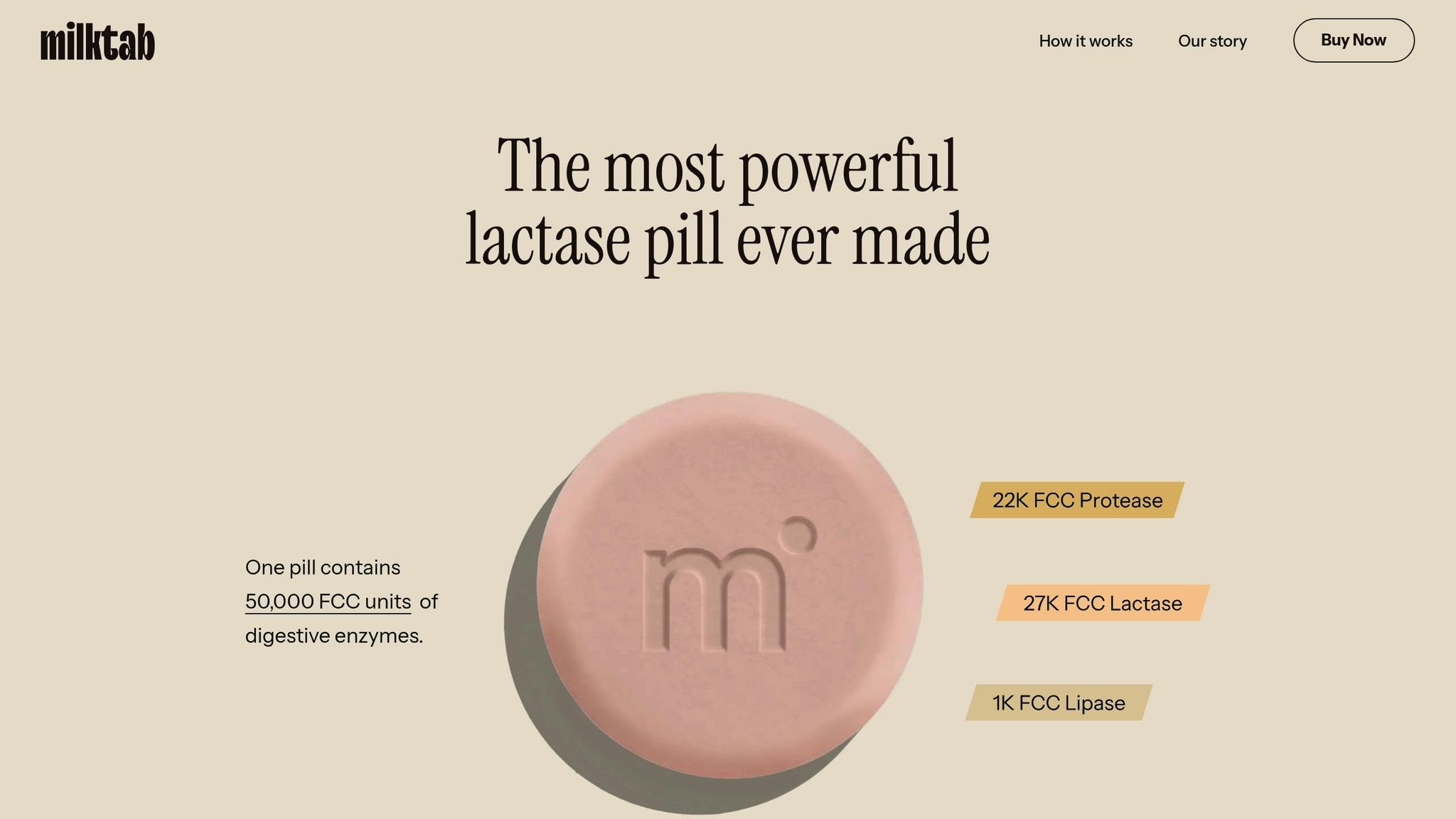
Enzyme supplements can help you enjoy dairy without the discomfort. When avoiding hidden lactose isn’t an option, milktab is a reliable choice for digestive support.
"Milktab really works – I enjoyed European cheeses on vacation!" - Juana
milktab’s triple-enzyme formula includes:
- 27,000 FCC lactase to break down lactose
- 22,000 FCC protease to digest milk proteins
- 1,000 FCC lipase to process dairy fats
These portable pills are perfect for dining out or traveling. Simply take one pill before eating dairy, with a limit of two pills per day. The formula is vegan, non-GMO, and FODMAP-friendly, making it a convenient option for managing dairy digestion.
Hidden Dairy & Reading Labels
Conclusion: Quick Tips for Finding Hidden Lactose
Managing lactose intolerance can feel challenging, but understanding food labels and being prepared makes it much easier. Here's a helpful guide to keep in mind:
| Action | Key Points to Remember |
|---|---|
| Label Reading | Carefully check ingredient lists for milk-based derivatives. |
| High-Risk Foods | Be cautious with processed meats, baked goods, and instant foods. |
| Medicine Check | Look for lactose monohydrate in medications and supplements. |
| Preparation | Carry enzyme supplements for unexpected dairy situations. |
These steps make it easier to identify and avoid hidden sources of lactose. When in doubt about a product's ingredients, it's best to err on the side of caution. As one satisfied Milktab user shared:
"Best on the market!! I have been using Lactaid for a while now, and they honestly were a hit or miss depending on how much lactose was in the food I was consuming. With Milktab, I don't have to worry about the pill not working because of how strong it is!"
Also, keep in mind that "non-dairy" labels don’t always guarantee a product is lactose-free. For unexpected dairy exposure, enzyme supplements like Milktab can provide relief and confidence.
To stay in control of your lactose intake, focus on these strategies:
- Carry enzyme supplements when dining out.
- Double-check ingredient labels, even on familiar items.
- Contact manufacturers if ingredient details are unclear.
With a little preparation and the right tools, you can navigate food choices and manage lactose intolerance effectively.
